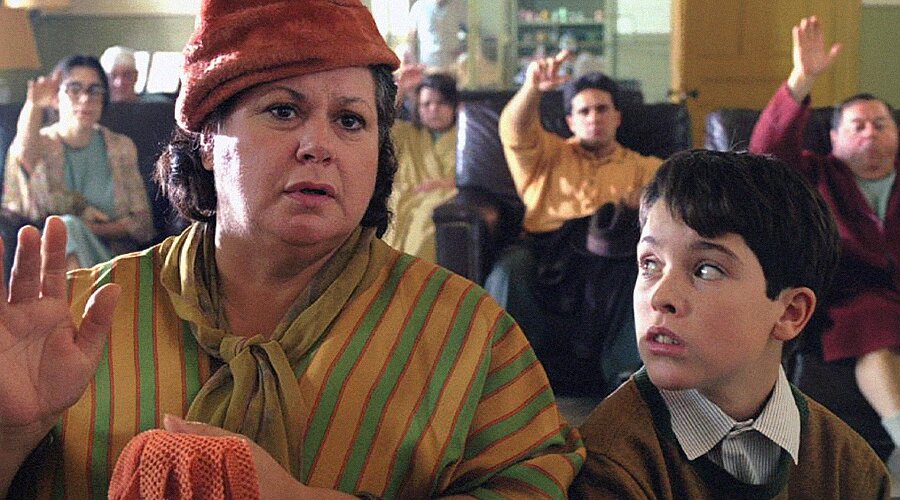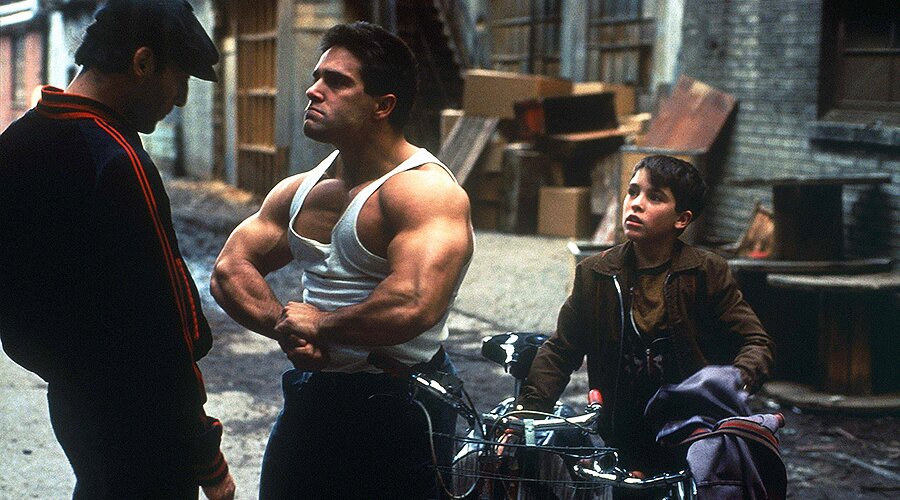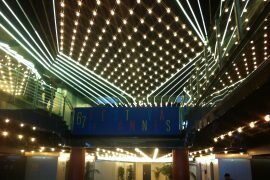It is said that great art often contains an element of contextual weirdness, a bit of the outré or taboo that contributes to the lasting impression that remains with us for years, even for a lifetime. If such an adage is true, then Léolo, directed by the robust filmmaker Jean-Claude Lauzon, endures in the cinematic annals as a masterwork of the very kind.
The narration in voiceover is that of a man reflecting on his childhood as Léo Lauzon, the poetic protagonist who uses his imagination to flee from the squalor and madness of his blue-collar home in the Mile-End neighborhood of Montreal. Making known early in the story that he rejects his name, used by those of his family who “believe only their own truth,” Léo adopts the moniker of Léolo Lozone as a tribute to the Italian neighbor who fills his fantasies and his notebooks. This imaginative obstinacy creates a precedent that takes hold of the story, and establishes its battleground: absorbing every moment of his childhood, and leavening the powerless experience of living in a single place and time, fantasy provides Léo a refuge from his confinement. And that fantasy, as it unravels in the story, is to lift him from confinement to an unforeseeable nobility.
Deriving the story from a semi-autobiographical tapestry, Jean-Claude Lauzon finished his career with Léolo, and died five years later with his girlfriend in a plane crash. His death deprived the cinema of a singular imagination and a personality that was bumptious, transgressive, and wildly inventive; but his second and final film, bringing together the extremes of disgust and beauty, of mean-spiritedness and nobility, has left for those who see it a trove of fantasy and memorable imagery. It is because of such extremes that Léolo remains a masterwork that envisions for the viewer new possibilities of life; while establishing itself at the junction of a poetic beauty and grotesque fancy, the film shifts between these two extremes and creates an atmosphere and characters that unify them.
The poetic qualities of the film are many, though they first surface in the narration that delivers a series of lines from the mind of Léo. That narration is of a wiser, more poetic Léo who transfigures the materials of his childhood with poetic refrains and an affirmation of his dreamland, of which we hear in voiceover, “everyone thinks I’m a French-Canadian. Because I dream, I am not.” The second of these sentences becomes the refrain, the poetic affirmation of the world of the mind, and the motif of an otherwise disorderly bricolage of invention.
The disorder is apparent in the sheer quantity of transgressive and nauseous imagery: coprophilia, bestiality, gallows humor, outright malice, and untrammeled insanity are just some of the many elements that exist in the story. The often impressionistic lighting of the cinematographer, Guy Dufaux, makes the squalid quarters of the Lauzon family into a hothouse that contains rats, a turkey in the bathtub, and a repository of insects. Shifting between fantasy and reality like the flurries of a snowstorm, the narration links the hothouse with the infernal foundry at which the father of Léo, a stolid and portly man, toils with a stupid smile.
And into the unremitting disorder and madness of the family, the narration in voiceover irrupts and delivers a tonic of beauty and wonder: “All I ask of a book,” says the narrator as we watch Léo begin to read by the light of a refrigerator, “is for it to inspire me with energy and courage…to tell me that there’s more to life than I can ever know.” The beauty of the poetic refrains, far from clashing with the grotesquerie of this hothouse, provides us the same respite as Léo contrives with his imagination; the refrains and the opposition of imagery, in addition to eliciting sympathy for Léo that is to extend to his family, early affirm the aesthetic success of the shifting between extremes that characterizes the whole film, as well as the fertile invention of its director.
The inclusion of so many elements of invention in the story could only be, for any director of any era, a financial and artistic gamble. But Jean-Claude Lauzon succeeds, the result being that his visions as manifested by the story are as tantalizing as they are improbable and sickening. This is a director with uncompromising standards that benefit those who enjoy art, but irk those whose patronage is the industry of the cinema; because Lauzon was often at odds with this industry, he tended to repudiate its financial backing and “once refused a $100,000 film prize in protest of the bureaucratic nature of Québec’s film funding.”
I suspect that only such independence could have created a film like Léolo.
Extending to a shadowy character by the name of “The Word Tamer,” the poetic beauty of the film pervades the fantasies that involve books, photographs, and streaks of inexplicable light, while the Italian beauty Bianca appears singing amid the ruins of Sicilian scenery. This “Word Tamer,” whom Léo compares to Don Quixote, dwells above a cellar that contains books and photographs and statuettes, embodying the refuge of the mind to which Léo often returns; it also illustrates the realm of art and the imagination that the film elevates, providing a setting rich in color and in decor.
As it continues to shift between its extremes, the story elaborates the cast of grotesques who are all, excepting the mother of Léo, wallowing in insanity. That they are insane hardly prevents our sympathizing with their plights, an achievement of the director as impressive as the aesthetic harmony of the film. The foremost example of a character who elicits sympathy is the bodybuilder and brother of Léo, Fernand. Having received a bloody nose from the local street tyrant, Fernand devotes himself to bodybuilding, fortifying himself for his next encounter. The transformation after some years is immense, and the narrator reflects that “since that day, fear had given my brother Fernand a reason to live.”
But the tyrant returns, and he again reduces Fernand to a whimpering and bloody victim. The scene surprises, but segues into a piece of the narration that reveals its timely humanity: “On that day,” says Léo, “I understood that fear lived in the deepest part of ourselves, and that a mountain of muscles or 1,000 soldiers couldn’t change a thing.” It is a poignant message that deepens the humanity of the character of Fernand, and lends to his strangeness a graceful normality and tenderness.
As that sympathy extends to the other characters, the story earns the status of art in introducing possibilities that reflect the deepest concerns of our condition; in such a depiction of the extremes of beauty and squalor, where reality and fantasy commingle, reality seems less explicable, and fantasy more, than conventional wisdom would indicate. In the story as in life, imagination and reality have equal claims to the world. The extremes of Léolo, however disturbing, are the perfect tools to convey this sensibility.
“Because I dream, I am not,” says the narrator in the poetic refrain. He affirms both the value of the story and the invention of its director, whose own childhood doubtless contained many of the same deprivations and fantasies of the Léo of the film. Although his death was a tragedy, his passionate artistry and talents endure in Léolo, a foremost masterwork of the Canadian cinema.
And the future of Léo is never in doubt, even as he bounds through the fields of Italy in the coda of the film.
The result of his teeming fantasy, his desperation to escape the madness and the squalor of his life, is the film Léolo. That is strongest recommendation that I can give to the film, and to the deathless genius of its director.







